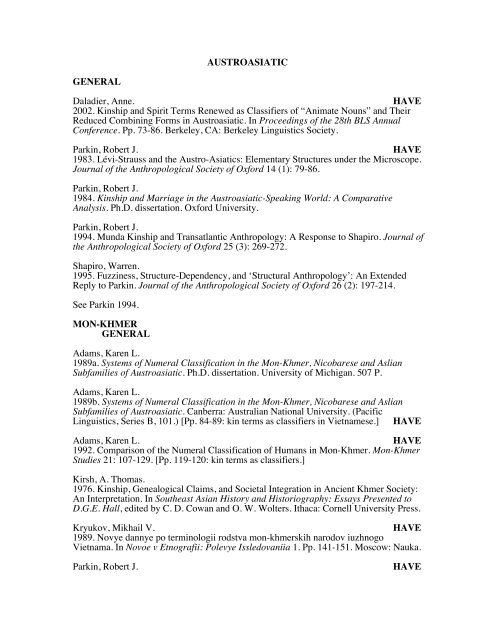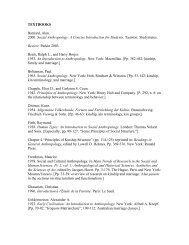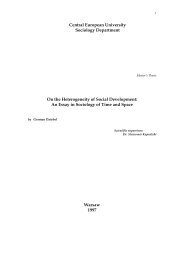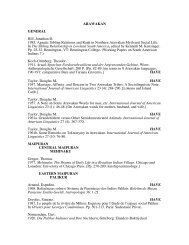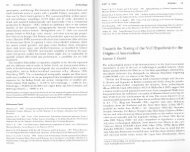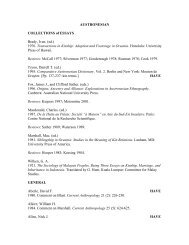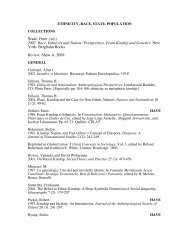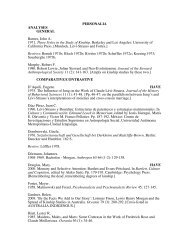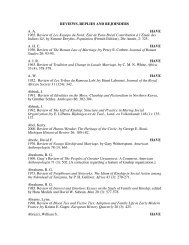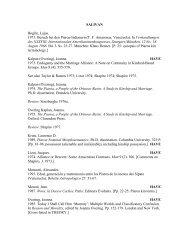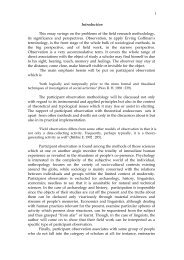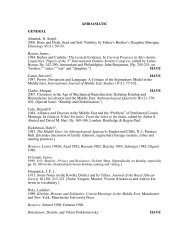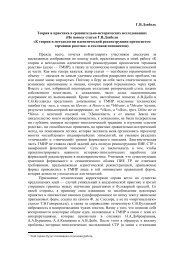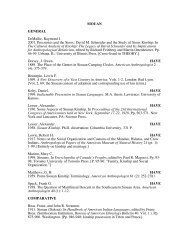6.4.Austroasiatic - Kinship Studies
6.4.Austroasiatic - Kinship Studies
6.4.Austroasiatic - Kinship Studies
You also want an ePaper? Increase the reach of your titles
YUMPU automatically turns print PDFs into web optimized ePapers that Google loves.
AUSTROASIATICGENERALDaladier, Anne.HAVE2002. <strong>Kinship</strong> and Spirit Terms Renewed as Classifiers of “Animate Nouns” and TheirReduced Combining Forms in Austroasiatic. In Proceedings of the 28th BLS AnnualConference. Pp. 73-86. Berkeley, CA: Berkeley Linguistics Society.Parkin, Robert J.HAVE1983. Lévi-Strauss and the Austro-Asiatics: Elementary Structures under the Microscope.Journal of the Anthropological Society of Oxford 14 (1): 79-86.Parkin, Robert J.1984. <strong>Kinship</strong> and Marriage in the Austroasiatic-Speaking World: A ComparativeAnalysis. Ph.D. dissertation. Oxford University.Parkin, Robert J.1994. Munda <strong>Kinship</strong> and Transatlantic Anthropology: A Response to Shapiro. Journal ofthe Anthropological Society of Oxford 25 (3): 269-272.Shapiro, Warren.1995. Fuzziness, Structure-Dependency, and ‘Structural Anthropology’: An ExtendedReply to Parkin. Journal of the Anthropological Society of Oxford 26 (2): 197-214.See Parkin 1994.MON-KHMERGENERALAdams, Karen L.1989a. Systems of Numeral Classification in the Mon-Khmer, Nicobarese and AslianSubfamilies of Austroasiatic. Ph.D. dissertation. University of Michigan. 507 P.Adams, Karen L.1989b. Systems of Numeral Classification in the Mon-Khmer, Nicobarese and AslianSubfamilies of Austroasiatic. Canberra: Australian National University. (PacificLinguistics, Series B, 101.) [Pp. 84-89: kin terms as classifiers in Vietnamese.] HAVEAdams, Karen L.HAVE1992. Comparison of the Numeral Classification of Humans in Mon-Khmer. Mon-Khmer<strong>Studies</strong> 21: 107-129. [Pp. 119-120: kin terms as classifiers.]Kirsh, A. Thomas.1976. <strong>Kinship</strong>, Genealogical Claims, and Societal Integration in Ancient Khmer Society:An Interpretation. In Southeast Asian History and Historiography: Essays Presented toD.G.E. Hall, edited by C. D. Cowan and O. W. Wolters. Ithaca: Cornell University Press.Kryukov, Mikhail V.HAVE1989. Novye dannye po terminologii rodstva mon-khmerskih narodov iuzhnogoVietnama. In Novoe v Etnografii: Polevye Issledovaniia 1. Pp. 141-151. Moscow: Nauka.Parkin, Robert J.HAVE
1986. Prescriptive Alliance in Southeast Asia: The Austroasiatic Evidence. Sociologus 36(1): 52-64.Parkin, Robert J.1988a. Prescription and Transformation in Mon-Khmer <strong>Kinship</strong> Terminologies.Sociologus 38 (1): 55-68.HAVEParkin, Robert J.1988b. Sur quelques correspondences et emprunts en termes de parenté Austroasiatiques.Bulletin de l’École Française d’Extrême-Orient 77: 315-320. Paris.Parkin, Robert J.1990. Descent in Old Cambodia: Deconstructing a Matrilineal Hypothesis. Zeitschrift fürEthnologie 115: 209-227.SPECIFICASLIANGENERALCarey, Iskandar.1976. Orang Asli: the Aboriginal Tribes of Peninsular Malaysia. Kuala Lumpur: OxfordUniversity Press. [Includes complete Temiar, Mendrik and Semelai kin terminologies anddescriptive notes on Orang Laut, Mah Meri and other Negrito kinship.]Evans, Ivor H. N.1937. The Negritos of Malaya. Cambridge: Cambridge University Press. [Pp. 302-303:Jehai and Lanoh kin terminologies.]Parkin, Robert J.HAVE1992. Cognates and Loans among Aslian Kin Terms. Journal of Siam Society 80, pt. 2:167-169. [Includes general typological description of Aslian kinship terminologies].NORTH ASLIANCHEWONG (SIWANG)Howell, Signe.1984. Equality and Hierarchy in Chewong Classification. Journal of the AnthropologicalSociety of Oxford 15 (1): 30-44. [Pp. 33-35: classification of humans, including kin.]Needham, Rodney.HAVE1956. Ethnographic Notes on the Siwang of Central Malaya. Journal of the MalayanBranch of the Royal Asiatic Society 29: 49-69. [Pp. 59-68: kinship and marriage,including terminology.]EASTERNBATEKEndicott, Kirk M.1974. Batek Negrito Economy and Social Organization. Ph.D. dissertation. HarvardUniversity.Endicott, Kirk M.1979. Batek Negrito Religion: the World-View and Rituals of a Hunting and Gathering
People of Peninsular Malaysia. Oxford: Clarendon Press. [P. 177: the classificatorynature of Batek kin terms and their use as honorifics.]Endicott, Kirk M.1999. The Batek of Peninsular Malaysia. In The Cambridge Encyclopedia of Hunters andGatherers, edited by Richard B. Lee and Richard Daly. Pp. 298-302. Cambridge:Cambridge University Press. [P. 300-301: kinship.]JEHAI (JAHAI)Eder, James F.1999. The Jahai of Northern Peninsular Malaysia. In The Cambridge Encyclopedia ofHunters and Gatherers, edited by Richard B. Lee and Richard Daly. Pp. 307-311.Cambridge: Cambridge University Press. [P. 309-310: kinship.]WESTERNKENSIW (MENDRIK)Bishop, Nancy.HAVE1996. Who’s Who in Kensiw? Terms of Reference and Address in Kensiw. Mon-Khmer<strong>Studies</strong> 26: 245-253.Carey, Iskandar.HAVE1968. Mendrik <strong>Kinship</strong> Terminology. Federation Museums Journal 13: 49-56. KualaLumpur.Carey, Iskandar.1970. The Kensiu Negritos of Baling, Kedah. Journal of the Malaysian Branch of theRoyal Asiatic Society 43 (1): 143-154. [Pp. 145-149: kinship and marriage, includingterminology.]HAVESENOICSEMAI-SENOIDentan, Robert K.HAVE1970. Hocus Pocus and Extensionism in Central Malaya: Notes on Semai <strong>Kinship</strong>Terminology. American Anthropologist 72 (2): 358-362.Robarchek, Carole.HAVE1980. Cognatic <strong>Kinship</strong> and Territoriality among the Semai-Senoi. Federation MuseumsJournal 25: 89-102.Schebesta, Paul.1927. Bei den Urwaldzwergen von Malaya. Leipzig: F.A. Brockhaus. [Pp. 113-114:Semang kin terminology.]English translation: Among the Forest Dwarfs of Malaya. Translated by Arthur Chambers.London: Hutchinson, 1928.Schebesta, Paul P.1928. Gesellschaft und Familie bei den Semang auf Malakka. Anthropos 23: 235-258.[Pp. 248-249: kin terminology.]HAVETEMIAR
Benjamin, Geoffrey.HAVE1966. Temiar Social Groupings. Federation Museums Journal 11: 1-25. Kuala Lumpur.Benjamin, Geoffrey.1967. Temiar <strong>Kinship</strong>. Federation Museums Journal 12: 1-25. Kuala Lumpur.HAVEBenjamin, Geoffrey.HAVE1968. Temiar Personal Names. Bijdragen tot de Taal-, Land- en Volkenkunde 124 (1):99-134. [Teknonyms, death-names, birth-order names.]Needham, Rodney.HAVE1964. Temer Names. Journal of the Malaysian Branch of the Royal Asiatic Society 37(205, pt. 1): 121-125. [Teknonyms and death-names.]SOUTH ASLIANBESISIKarim, Wazir-Jahan.HAVE1980. The Nature of <strong>Kinship</strong> in Ma’Betisék Villages. Federation Museums Journal 25:121-135.EAST MON-KHMERBAHNARICGENERALGuilleminet, Paul.1952. La tribu Bahnar du Kontum (Plateau de L’Indochine Centrale). Contribution àl’étude de la société montagnarde du Sud Indochinois. Bulletin de l’Écôle Françaised’Extrême-Orient 45 (2): 393-561. [Pp. 486-495: family, kinship, and marriage, includinga comparative table of Bahnaric kin terms.]HAVENORTH BAHNARICWESTJEH-HALANGJEHGradin, Dwight.1972. Rites of Passage among the Jeh. Southeast Asia: An International Quarterly 2 (1):53-61. [P. 54: kin terminology.]RENGAO (REUNGAO)Kemlin, J. Emile.1917. Alliances chez les Reungao. Bulletin de l’École Française d'Extrême-Orient 17 (4):1-119.Republished in Les Reungao: Rites Agraires, Songes et Alliances. Une Société Proto-Indochinoise du Viêt Nam au Début du XXe Siècle, par Emile Kemlin. Textes réunis etprésentés par Pierre Le Roux. Pp. 165-283. Paris: École Française d’Extrême-Orient., 1998.Le Roux, Pierre.1998. L’ethnologue Émile Kemlin. In Les Reungao: Rites Agraires, Songes et Alliances.Une Société Proto-Indochinoise du Viêt Nam au Début du XXe Siècle, par Émile Kemlin.
STIENGGerber, T.1951. Coutumier Stieng. Bulletin de l’École Française d’Éxtreme-Orient 45 (1): 227-271.WEST BAHNARICBRAO-KRAVETLAVEHours, Bernard.1973. Les rites de défense chez les Lavè du Sud-Laos. Asie du Sud-Est et MondeInsulindien 4 (3): 31-60. [Pp. 50-52: kinship structure and ritual].HAVEKATUICGENERALSmith, Kenneth D.HAVE1989. <strong>Kinship</strong> Variation among Vietnam Language Groups. Mon-Khmer <strong>Studies</strong> 15: 21-86.WEST KATUICBROU-SOBRUMiller, John D.1972. Bru <strong>Kinship</strong>. Southeast Asia: An International Quarterly 2 (1): 62-70.HAVEVargyas, Gábor.2000. À la Recherche des Brou Perdus, Population Montagnarde du Centre Indochinois.Paris: Études Orientales. [Pp. 218, 245-256: kin terms in early wordlists.] HAVEKHMERBitard, Pierre.1955. La literature cambodgienne moderne. France-Asie 12 (114-115): 467-479.[Includes notes on the use of kin terms in Khmer.]HAVEEbihara, May M.1968. Svay, a Khmer Village in Cambodia. Ph.D. dissertation. Columbia University. [Pp.656-677: Central Khmer kin terminology.] HAVEEbihara, May M.1984. Societal Organization in 16th and 17th Century Cambodia. Journal of SoutheastAsian <strong>Studies</strong> 15 (2): 280-295.Ebihara, May M.1977. Residence Patterns in a Khmer Peasant Village. Annals of the New York Academyof Sciences 293: 52-53.Jenner, Philip N.HAVE1976. A Possible Case of Cosmological Gender in Khmer. In Austroasiatic <strong>Studies</strong>, PartII, edited by Philip N. Jenner, Laurence C. Thompson, and Stanley Starosta. Pp. 711-740.
Honolulu: University Press of Hawaii. [Pp. 726-727, 728-729: paired kin terms forparents, siblings and uncle/nephew and the order of their components.]Kirsch, A. Thomas.1976. <strong>Kinship</strong>, Genealogical Claims, and Societal Integration in Ancient Khmer Society:An Interpretation. In Southeast Asian History and Historiography: Essays Presented toD. G. E. Hall, edited by C. D. Cowan and O. W. Wolters. Pp. 190-202. Ithaca, N.Y.:Cornell University Press.Ledgerwood, Judy L.1990. Changing Khmer Conception of Gender: Women, Stories and the Social Order.Ph.D. dissertation. Cornell University.Ledgerwood, Judy L.HAVE1995. Khmer <strong>Kinship</strong>: The Matriliny/Matriarchy Myth. Journal of AnthropologicalResearch 51: 247-261.Martel, G.1975. Lovea, Village des Environs d'Angkor: Aspects Demographiques, Economiques etSociologiegues. Paris: Publications de l'Ecole Francaise d'Extreme-Orient.Maspéro, Georges.1929. Un Empire Colonial Français, l'Indochine. T. I. Le Pays et ses Habitants.L'histoire. La Vie Sociale. Paris and Bruxelles: Éditions G. Van Oest. [Pp. 264-268:Khmer kin terminology.]O’Sullivan, Kevin.1962. Concentric Conformity in Ancient Khmer <strong>Kinship</strong> Organization. Bulletin of theInstitute of Ethnology, Academia Sinica 13: 87-96.NICOBARGENERALMann, Rann S.2005. Andaman and Nicobar Tribes Restudied: Encounters and Concerns. Delhi: Mittal.[Pp. 91-92: Nicobar exogamy, no cousin marriage, no clans, kindred (uder).]Nandan, Anshu P.1993. The Nicobarese of Great Nicobar: An Ethnography. New Delhi: Gyan. [Pp. 43-62:“Social structure,” including pp. 49-60 on kin terminology and behavior.]Shashi, S. S. ë1994. Social Structure of Nicobar Village. In Encyclopedia of Indian Tribes. Vol. 7.Island Tribes of Andaman and Nicobar, edited by S. S. Shashi. Pp. 182-203. New Delhi:Anmol. [Extensively on kinship, marriage and the family.]CARDas A. R.1977. A Study on the Nicobarese Language. Calcutta: Anthropological Survey of India,Government of India. [Pp. 33-34: kin terms.]
Justin, Austin.1990. The Nicobarese. Calcutta: Seagull Press for the Anthropological Survey of India.[Pp. 43-60: marriage, kinship, residence among the Car Nicobarese; 54-56: Car kinterminology.]Whitehead, George.1925. Dictionary of the Car-Nicobarese language. Rangoon: American Baptist MissionPress.Reprinted in New Delhi: AES, 1993. [P. 191: sibling terminology.]NORTH MON-KHMERKHASIANKHASIBecker, Carl H.1924-1925. Familienbesitz und Mutterrecht. Zeitschrift für Buddhismus und VerwandteGebiete 6 (n.s. 3):127-138, 300-310.Becker, Carl H.1925. Familienbesitz und Mutterrecht in Assam. München-Neubiberg: O. Schloss.Chattopadhyay, K. P.1941. Khasi <strong>Kinship</strong> and Social Organization. Calcutta University AnthropologicalPapers 6: 1-39.Chattopadhyay, K. P.HAVE1942. Khasi <strong>Kinship</strong> and Social Organization. In Proceedings of the 28 th Indian ScienceCongress, Benares, 1941. P. 218. Calcutta: Indian Science Congress Association.Ehrenfels, Uriel R.1953. Khasi <strong>Kinship</strong> Terms in Four Dialects. Anthropos 48 (3-4): 396-412.HAVEGurdon, P. R. T.1907. The Khasis. London: D. Nutt. [Marriage, divorce, inheritance, clans.]Jirwa, M. B.HAVE1999. <strong>Kinship</strong> Terms in Khasi. In Languages of the North East (Assamese, Khasi,Manipuri, Mising and Rabha), edited by P. N. Dutta Baruah. Pp. 170-187.Manasagangotri, Mysore: Central Institute of Indian Languages.Majumdar, D. N.1960. Lineage Structure in a Himalayan Society, Himalayan District. InternationalJournal of Comparative Sociology 1: 17-42. [Khasa (Khasi).]Nongkinrih, Aurelius K.2002. Khasi Society of Meghalaya: A Sociological Understanding. New Delhi: Indus.[Pp. 33-65: “<strong>Kinship</strong> and Marriage.”]Nongbri, Tiplut.1984. Problems of Matriliny: A Short Review of the Khasi <strong>Kinship</strong> Structure. Journal ofNorth-East India Council for Social Science Research 8 (1): 1-10. Shillong.
Nongbri, Tilput.1996. Problems of Matriliny: A Short Review of Khasi <strong>Kinship</strong> Structure. In <strong>Kinship</strong> andFamily in North-East India, edited by J. S. Bhandari. Pp. 329-346. New Delhi: CosmoPublications.Rabel-Heymann, Lili.1989. Khasi <strong>Kinship</strong> Terminology. In South-East Asian Linguistics: Essays in Honour ofEugénie J. A. Henderson, edited by Jeremy H. C. S. Davidson and R. H. Robins. Pp. 43-57. London: School of Oriental and African <strong>Studies</strong>, University of London.Roi Rai Bahadur, Sarat C.1921. Khasi <strong>Kinship</strong> Terms. Man in India 1: 233-238.HAVESanwall, R. D.HAVE1966. Bridewealth and Marriage Stability among the Khasi of Kumaon. Man 1: 46-59.Shanta, K.M.1980. <strong>Kinship</strong> Terms in Khasi. Indian Linguistics 41 (3-4): 139-150. Pune.PNARBanerjee, Sukumar.HAVE1963. Pnar <strong>Kinship</strong> System. Bulletin of the Anthropological Survey of India 12 (3-4):165-170.Sinha, A. P.1985. The Pnar Family. In The Tribal Institutions of Meghalaya, edited by S. K.Chattopadhyay. Gauhati: Spectrum.KHMUICMAL-KHMU’KHMUDang Nghiem Van.1973. Le Khmu au Viet Nam. Études Vietnamiennes 36: 69-148.Lindell, Kristina, Rolf Samuelsson, and Damrong Tayanim.1979. <strong>Kinship</strong> and Marriage in Northern Kammu Villages: The <strong>Kinship</strong> Model.Sociologus 29 (1): 60-84.HAVEMLABRIRischel, Jørgen.1995. Minor Mlabri: A Hunter-Gatherer Language of Northern Indochina. Copenhagen:Museum Tusculanum Press. [Pp. 116-132: kin terminology.]HAVEReview: Thurgood 1998.Suebsaeng, Nipatwet.HAVE1992. The Mlabri Family and <strong>Kinship</strong> System. In The Phi Tong Lueng (Mlabri): AHunter-Gatherer Group in Thailand, edited by Surin Pookajorn, Pp. 75-91. Bangkok,Thailand: Faculty of Archaeology, Silapakorn University; Odeon Store.
PALAUNGICWESTERN PALAUNGICANGKUICTAI LOI (CAK)Bernot, Lucien.1967. Les Cak: Contribution à l'Étude Ethnographique d’une Population de Langue Loi.Paris: Éditions du Centre National de la Recherche Scientifique. [Pp. 94-105: kinshipsystem and terminology.]HAVEReview: Löffler 1967a.LAMETICIzikowitz, Karl G.1951. Lamet: Hill Peasants in French Indochina. Göteborg: Etnografiska Museet.(Etnologiska Studier, 17.) [Pp. 90-98: kin terminology and teknonymy.] HAVELöffler, Lorenz G.1962. Der Einfluß der Matripatrilokalitat auf das Verwandtschaftsterminologiesystemder Lamet. Zeitschrift für Ethnologie 87 (1): 12-20.Needham, Rodney.1960. Alliance and Classification among the Lamet. Sociologus 10 (2): 97-119.HAVEWAICLAWAKunstadter, Peter.1965. The Lua' (Lawa) of Northern Thailand: Aspects of Social Structure, Agriculture,and Religion. Princeton: Center of International <strong>Studies</strong>.Kunstadter, Peter.HAVE1966. Residential and Social Organization of the Lawa of Northern Thailand.Southwestern Journal of Anthropology 22 (1): 61-84. [Marriage exchange, patrilineages.]WADiffloth, Gérard.1980. The Wa Languages. Linguistics of the Tibeto-Burman Area 5 (2): 1-182. [P. 167:index of kin terms in the etymological dictionary.]VIET-MUONGMUONGMUONGPathy, Jaganath.2004. Muong. In Encyclopaedia of the South East Asian Ethnography, edited byNarendra S. Bisht and T. S. Bankoti. Pp. 481-486. Delhi: Global Vision. [Pp. 482 483:kinship, marriage, family.]VIETNAMESEBenedict, Paul K.HAVE
1947. An Analysis of Annamese <strong>Kinship</strong> Terms. Southwestern Journal of Anthropology3 (4): 371-391.Cadière, L.1930. La famille et la religion en pays Annamite. Bulletin des Amis du Vieux Hué 17 (4):353-413.Cadière, L.1931. Die Familie bei den Anamiten. Anthropos 26: 962.Di Domenico, Elisa.2003. Displaced Reference and Tense/Person Marking in Isolating Languages. InGenerative Grammar in a Broader Perspective: Proceedings of the 4 th Glow in Asia2003, edited by Hang- Jin Yoon. Pp. 151-172. Seoul: Hankook. [P. 162: kin terms aspersonal pronouns in Vietnamese.]Emeneau, M. B.1951. <strong>Studies</strong> in Vietnamese (Annamese) Grammar. University of California Publicationsin Linguistics 8: 1-236. [P. 101: classifiers on human nouns, including kin terms.]Grammont. Maurice, and Lê Quang Trinh.1911-1912. Études sur la langue Annamite. Mémoires de la Société de Linguistique deParis 17: 201-241. [Pp. 220-223: kin terms, and their use in sentences.]Hickey, Gerald C.1964. Village in Vietnam. New Haven and London: Yale University Press. [Pp. 82-99:“The <strong>Kinship</strong> System,” including kin terminology (pp. 82-88).]HAVEHien, Nguyen Xuan.2007. Glutinous Rice, <strong>Kinship</strong> and the Têt Festival in Vietnam. In <strong>Kinship</strong> and Food inSoutheast Asia, edited by Monica Janowski and Fiona Kerlogue. Pp. 242-265.Copenhagen: Nordic Institute of Asian <strong>Studies</strong>.Hoa, Nguyen Dinh.HAVE1957. Classifiers in Vietnamese. Word 13 (1): 124-152. [Extensively on kin terms asclassifiers.]Hoang, Erik M.1996. A Production Grammar for Vietnamese <strong>Kinship</strong> Terminology. Linguistic Analysis26 (3-4): 216-226.Huffmanm Franklin E., and Tran Trong Hai.1980. Intermediate Spoken Vietnamese. Ithaca: Southeast Asia Program, CornellUniversity. [Pp. 176-178: kinship pronouns; 276-278: kin terms]HAVEHuynh Dinh Te.1988. Interpersonal Relationships as Reflected in the Vietnamese Language [<strong>Kinship</strong>Terminology]. Journal of Vietnamese <strong>Studies</strong> 1: 44-47. Melbourne.Kibria, N.1994. Household Structure and Family Ideologies: The Dynamics of ImmigrantEconomic Adaptation among Vietnamese Refugees. Social Problems 41: 81-95.Krowolski, Nelly.HAVE
1999. Du dedans au dehors: Le vocabulaire de parenté. In Mông Phu: Un Village duDelta du Fleuve Rouge, édité par Nguyê n Tùng. Pp. 109-135. Paris: ÉditionsL’Harmattan.Löbel, Elisabeth.2000. Classifiers versus Genders and Noun Classes: A Case Study in Vietnamese. InGender in Grammar and Cognition, edited by Barbara Unterbeck, Matti Rissanen, TerttuNevalainen and Mirja Saari. Pp. 259-319. Berlin and New York: Mouton de Gruyter. [P.304: kin terms as requiring no classifier for the reason of their uniqueness.] HAVELuong, Hy Van.HAVE1984. “Brother” and “Uncle”: An Analysis of Rules, Structural Contradictions, andMeaning in Vietnamese <strong>Kinship</strong>. American Anthropologist 86 (2): 290-315.Errata: American Anthropologist, 1984, 86 (3): 705.Luong, Hy Van.1986. Language, Cognition, and Ontogenetic Development: A Reexamination of Piaget’sPremises. Ethos 14 (1): 7-46. [Kin term acquisition as exemplified by Vietnamese; Crosslistedin THEORY.]Luong, Hy Van.HAVE1989. Vietnamese <strong>Kinship</strong>: Structural Principles and the Socialist Transformation inNorthern Vietnam. Journal of Asian <strong>Studies</strong> 48 (4): 741-756.Merten, Stephan.1990. Zweitspracherwerb und kulturelles Lernen. Wirkendes Wort: Deutsche Spracheund Literatur in Forschung unf Lehre 40 (2): 268-284. [Vietnamese kin terms and formsof address compared to German; Cross-listed in INDO-EUROPEAN.]Merten, Stephen.HAVE1994. Die sprachliche und gesellschaftliche Interpretation von Welt: Farben undVerwandtschaftsbezeichnungen. Sociologus 44 (2): 149-165. [Vietnamese compared toGerman; Cross-listed in THEORY and INDO-EUROPEAN.]Preisig, Elisabeth.1982. Relations Interpersonnelles dans la Famille Vietnamienne: Étude Ethnolinguistiquedu Système d’Appellation Interpersonnelle du Dialecte de la Région de Hanoi. Ph.D.dissertation. École des Hâutes Études en Sciences Sociales. 399 P.Spencer, Robert F.HAVE1945. The Annamese <strong>Kinship</strong> System. Southwestern Journal of Anthropology 1 (2): 284-310.Thompson, Laurence C.1965. A Vietnamese Grammar. Seattle: University of Washington Press. [Pp. 198, 294-297:kin terminology and kin classifiers.]HAVETran-van-Trai.1942. La Famille Patriarcale Annamite. Paris: P. Lapagesse.Translated into English as The Annamese Patriarchal Family, by Tran-van-Trai. NewHaven: Human Relations Area Files, 1970-1976.
Yu, Insun.2001. The Bilateral Social Pattern and the Status of Women in Traditional Vietnam.Vietnamese <strong>Studies</strong> 142: 25-45. Hanoi.MUNDAGENERALBhattacharya, Sudhibhushan.1970. <strong>Kinship</strong> Terms in the Munda Languages. Anthropos 65 (1/2): 444-465.HAVEBhattacharya, Sudhibhushan.HAVE1976. Gender in the Munda Languages. In Austroasiatic <strong>Studies</strong>. Pt. 1, edited by PhilipJenner, Laurence C. Thompson and Stanley Starosta. Pp. 189-211. Honolulu: UniversityPress of Hawaii. [Especially pp. 198-203: gender in kin terms.]Parkin, Robert J.HAVE1986. Comparative Munda <strong>Kinship</strong>: A Preliminary Report. Oxford University Papers onIndia 1 (pt. 1): 59-74.Parkin, Robert J.HAVE1988. Marriage, Behaviour and Generation among the Munda of Eastern India. Zeitschriftfür Ethnologie 113 (1): 67-86.Parkin, Robert J.1992. The Munda of Central India: An Account of Their Social Organization. Delhi:Oxford University Press. [Pp. 122-240: kin terminologies, alliance, alternate generationequivalence, etc.]Review: Morris 1993; Shapiro 1994; Trautmann 1994; Trivedi 1997.Pfeffer, Georg.1996. The Young and the Junior Set in Tribal Middle India: On the Category of Age. InContemporary Society: Childhood and Complex Order. Professor Satya Narayana RathaFestschrift, edited by Georg Pfeffer and Deepak Kumar Behera. Pp. 89-109. New Delhi:Manak.Volchok, B. Ya.1959. Sledy dual’noi organizatsii u narodov munda. Sovetskaia Etnografia 6: 113-117.[Includes discussion of Ho and Kharia kin terminologies.]Zide, Norman H., and Arlene R. K. Zide.HAVE1991. A Linguistic Analysis of Some South Munda <strong>Kinship</strong> Terms. In AustroasiaticLanguages: Essays in Honor of H. L. Shorto, edited by Jeremy H. C. S. Davidson. Pp.43-59. London: University of London School of Oriental and African <strong>Studies</strong>.SPECIFICNORTH MUNDAKHERWARIAGARIAElwin, Verrier.1942. The Agaria. Oxford: Oxford University Press. [Pp. 58-85: totemism andexogamous groups.]
BIJORI (BINJHIA)Kerketta, Sushil.1996. The Binjhias. Calcutta: Institute of Social Research and Applied Anthropology.[Pp. 41-49: kin terminology (influenced by Hindi) and kin behavior.]HAVEKORAKU (KORKU)Fuchs, Stephen.1988. The Korkus of the Vindhya Hills. New Delhi: Inter-India Publications. [Pp. 165-167: kin terminology.] HAVEGandhi, L. P.1988. A Glimpse of Marriage Pattern and Practices among the Korku. In Marriage inIndia: Tribes, Muslims, and Anglo-Indians, edited by B. B. Goswami, J. Sarkar, and D.Danda. Pp. 210-216. Calcutta: Anthropological Survey of India.Zide, Norman H.HAVE1958. Some Korku <strong>Kinship</strong> Terms in Proto-Munda. Bulletin of the Tribal Research andDevelopment Institute, Bhopal 1: 10-21.Zide, Norman H.1963. Korku Noun Derivational Morphology. Unpublished manuscript. University ofChicago.Summarized in: Austroasiatic Languages: A Linguistic Bibliography, by K. S. Nagaraja.Pune: Deccan College Post-Graduate and Research Institute, 1989, p. 33. On special dualsand plurals of kin terms.MUNDARIGENERALShashi, S. S.1994. Aspects of Mundas of 24 Parganas. In Encyclopedia of Indian Tribes. Vol. 12.West Bengal and Orissa, edited by S. S. Shashi. Pp. 67-85. New Delhi: Anmol.[Extensively on clans and lineages.]BIRHORAdhikary, Ashim K.1984. Society and World View of the Birhor: A Nomadic, Hunting, and GatheringCommunity of Orissa. Calcutta: Anthropological Survey of India. 99 P.Adhikary, Ashim K.1999. The Birhor. In The Cambridge Encyclopedia of Hunters and Gatherers, edited byRichard B. Lee and Richard Daly. Pp. 248-251. Cambridge: Cambridge University Press.[P. 250: kinship.]Malhotra, S. P.HAVE1963. <strong>Kinship</strong> Organization Among the Birhors. Bulletin of the Bihar Tribal ResearchInstitute 5 (2): 311-324.Roy, Sarat C.
1925. The Birhors: A Little Known Jungle Tribe of Chata Nagpur. Ranchi. [Pp. 124-142:kin terminology.]HAVESahu, Chaturbhuj.1995. Birhor Tribe (Dimensions of Development). New Delhi: Sarup& Sons. [Pp. 80-81:kin terminology.]Williams, B. J.1968. The Birhor of India and Some Comments on Band Organization. In Man the Hunter,edited by Richard B. Lee and Irven DeVore. Pp. 126-137. Chicago: Aldine. [<strong>Kinship</strong> andmarriage.]HOBouez, Serge.1990. L’alliance classificatoire chez les Ho: Préférence ou prescription. In LesComplexités de l’Alliance, edited by Françoise Héritier-Augé and Elisabeth Copet-Rougier. Vol. 1. Les Systèmes Semi-Complexes. Pp. 1-22. Paris: Éditions des ArchivesContemporaines.Chatterjee, Anathnath, and Tarakchandra Das.1927. The Hos of Seraikella. Calcutta: Calcutta University Press. (AnthropologicalPapers, University of Calcutta 1.) [Pp. 50-57: kin terminology.]HAVEChattopadhyay, Gouranga.HAVE1964. <strong>Kinship</strong> and Marriage Among the Hos. Bulletin of the Cultural Research Institute 3(2): 13-25.Majumdar, D. N.1924. On the Terminology of Relationship of the Hos of Kolhan. Journal andProceedings of the Asiatic Society of Bengal 20 (5): 199-204.HAVEMisra, Kamal K.1987. Social Structure and Change among the Ho of Orissa. New Delhi: Gyan Books.[Pp. 23-29: kinship.]KODAKUSingh, Bageshwar.HAVE1977. Kodaku <strong>Kinship</strong> System. In Chhattisgarh: An Area Study, edited by Ajit K. Danda.Pp. 74-82. Calcutta: Anthropological Survey of India. [Ethnic Kodaku speak Korwa.]KORWABhandari, J. S.HAVE1963. <strong>Kinship</strong>, Marriage and Family Among the Korwa of Dudhi. (Mirzapur, U. P.).Eastern Anthropologist 16 (2): 78-106.Sandhwar, Abanindra N.1978. The Korwa of Palamau: A Study of their Society and Economy. (Acta Ethnologicaet Linguistica 44. Series Indica 9.) Wien. [Pp. 318-319: kin terminology.] HAVEMUNDARIGENERAL
Karve, Iravati.HAVE1968-1969. <strong>Kinship</strong> Organization in India and the Place of Mundari-Speaking People inIt. Adibasi 10 (1): 1-25. [Includes Juang, Korku, Saora, Bondo, Bhuinya, Khasi, Santhaland Mundari kin terminologies.]ASURIJain, R. K.HAVE1959. Features of <strong>Kinship</strong> in an Asur Village. Eastern Anthropologist 12 (1): 25-40.Leuva, K. K.1963. The Asur: A Study of Primitive Iron-Smelters. New Delhi: Bharatiya AdimjatiSevak Sangh. [Pp. 62-73: kin terminology and behavior.]HAVEMUNDARIDas, Tarakchandra.1961. The Bhumijas of Seraikella. Calcutta: University of Calcutta. [Dialect of Mundari.Pp. 29-35: kin terminology.]HAVESANTALIBiswas, Prophilla C.1956. Santals of the Santal Parganas. Delhi: Bharatiya Adimjati Sevak Sangh. [Pp. 53-58: partial kin terminology, and kin attitudes.]Bouez, Serge.1975. Parenté et hierarchie chez les Santal. L’Homme 15 (3-4): 109-128.HAVEBouez, Serge.1985. Réciprocité et Hiérarchie: L’Alliance chez les Hos et les Santals de l’Inde. Paris:Société d’Ethnographie.Reviews: Toffin 1986; Deliège 1987; Parkin 1987; Baks 1990.Gautam, Mohan K.1998. Santal-Munda <strong>Kinship</strong> and Family. In Changing Patterns of Family and <strong>Kinship</strong> inSouth Asia. Proceedings of an International Symposium on the Occasion of the 50thAnniversary of India's Independence held at the University of Helsinki 6 May 1998,edited by Asko Parpola and Sirpa Tenhunen. Pp. 111-128. Helsinki: Finnish OrientalSociety. [Includes kin terms.]Ghosh, Arun.1981. Santali <strong>Kinship</strong> Terminology: A Sociolinguistic Perspective. Calcutta Papers inLinguistics 1 (1): 7-23.Kochar, Vijay.1970. Social Organization among the Santal. Calcutta: Editions Indian.Mitra, Kakali, Paul, Sujit Kumar, and Hazra, Amit1999. Santal Orak: An Introspection on Interpersonal Relationships. Man in India 79 (3-4): 405-412. [Kin relations among the Santals.]
Pussetto, Luigi.1978. La parentela fra i Santal del Bangladesh. L’Uomo 2 (2): 3-42.SOUTH MUNDAKHARIA-JUANGJUANGBose, Nirmal K.1928. Marriage and <strong>Kinship</strong> Among the Juangs. Man in India 8 (4): 233-242.HAVEDash, J.1980. A Peep into the Juang <strong>Kinship</strong> System. Orissa Historical Research Journal 24-26:113-122. Bhubaneswar.McDougal, Charles W.1963a. The Social Structure of the Hill Juang. Ph. D. dissertation. University of NewMexico.McDougall, Charles W.1063b. The Social Structure of Hill Juang: A Précis. Man in India 43 (3): 183-191.McDougal, Charles.1964. Juang Categories and Joking Relations. Southwestern Journal of Anthropology 20(4): 319-345. [P. 329: kin terminology.] HAVEKHARIARoy, Sarat C.1937. The Khāriās. Ranchi: “Man in India” Office. [Pp. 146-159: kin terminology.] HAVEShashi, S. S.1994. Introduction to Hill Kharia of Purulia. In Encyclopedia of Indian Tribes. Vol. 12.West Bengal and Orissa, edited by S. S. Shashi. Pp. 28-66. New Delhi: Anmol. [Pp. 37-40: family and kinship.]KORAPUT MUNDAGUTOB-REMO-GETA’GETA’DIDAYI (GATA)Siddiqui, M. K. A.HAVE1976. The Didayi <strong>Kinship</strong> System. Bulletin of the Anthropological Survey of India 25(3/4): 1-8.GUTOB-REMOGENERALPfeffer, Georg.1999. Gadaba and Bondo <strong>Kinship</strong> Vocabularies versus Marriage, Descent, andProduction. In Contemporary Society. Tribal <strong>Studies</strong>. Professor Satya Narayana RathaFelicitation Volumes. Vol. 4: Social Realities, edited by Deepak K. Behera and GeorgPfeffer. Pp. 17-46. New Delhi: Concept Publishing House.BONDO
Elwin, Verrier.1950. Bondo Highlander. Oxford: Oxford University Press. [Appendix 1: kinterminology.]HAVEGADABAPfeffer, Georg.1992. Der intro-agnatische ‘Seelentausch’ der Gadaba beim groben Lineageritual. InBeitrage zur Ethnologie Mittel-und Südindiens, herausgegeben von M. Lauscher. Ss. 59-92. Munich: Anacon.SORA-JURAY-GORUMGORUMPARENGAPattanayak, D. P.HAVE1968. Some Comments on Parenga <strong>Kinship</strong> Terms. In <strong>Studies</strong> in Indian Linguistics.Professor M. B. Emeneau Sastipūrti Volume, edited by Bhadriradju Krishnamurti. Pp.250-256. Annamalainagar: Deccan College, Poona University and Annamalai University,Centers of Advanced Study in Linguistics.SORA-JURAYSAORA (SORA)Chaussin, Élisabeth.1978. Aspects spatiaux de l’organisation sociale des Saora. L’Homme 18 (1): 167-182.Narayana, P. L.1972. Saora <strong>Kinship</strong> Terminology. Folklore: International Journal 13 (3): 91-96.Calcutta.HAVE


